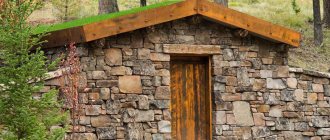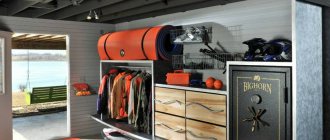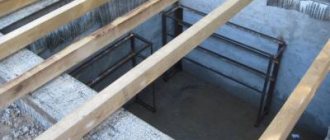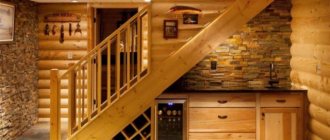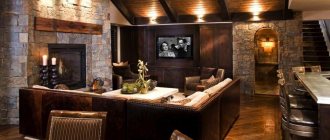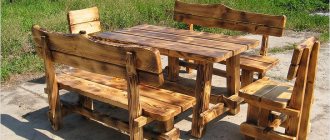Cellar at the foot of the hill When purchasing a plot of land on which not only construction will be carried out, but also crops will be grown, poultry and some kind of livestock will be kept, the owner will inevitably think about where and how he will have to store the fruits of his labor. In general, there is no other way out except to build and equip a special storage facility for this.
What will it be: a basement under a house or barn, or a cellar located separately at the far end of the garden? Which is better to choose, and what is the fundamental difference between a cellar and a basement?
In our article we will try to cover these issues in as much detail as possible, and will also give our readers some useful recommendations that cannot but come in handy in the construction of such structures.
Cellar - advantages and disadvantages
A cellar is a pantry in which food supplies are stored. Outwardly, it resembles a pit with walls reinforced with brick, wood, stone or concrete. If the soil is dense enough and the groundwater is low, wall cladding can be abandoned, which greatly facilitates the construction of the storage facility. Another advantage of a properly built cellar is a consistently low temperature throughout the entire 12 months. It should not fall below 0ºС or rise above +5ºС. Such conditions guarantee the safety of the crop and conservation.
If groundwater passes close to the surface, it will not be possible to equip a full-fledged underground storage facility. Moisture entering a basement or cellar that is not protected by waterproofing causes considerable damage to the crops stored there. An alternative is semi-buried or even above-ground storage. Its construction requires the use of insulating materials, which increases the financial costs of building a storage room. However, they are not as high as the cost of waterproofing an underground storage facility or basement.
How to place a cellar on the site
The requirements for its placement on the site are exactly the same as for other outbuildings. These issues are regulated by SP 53.13330.2019.
The cellar must be built no closer than 1 meter from the boundaries of the neighboring plot, and if the roof of the cellar has a cornice overhang of more than 50 cm, the distance will need to be measured from this overhang, and not from the wall. The red line of the street (if it runs nearby) from the building must be at least 5 meters, and the distance to a residential building can be any distance.
There are also common sense considerations. So, if on your site the toilet is a cesspool with a plank house on top, obviously the cellar should be moved away from it. You also need to leave at least six meters to the septic tank and bathhouse (with its inevitable wastewater). It’s also worth racking your brains about how your cellar will be located in relation to the neighbor’s communications - if your neighbor has a bathhouse behind a fence, then it’s better not to build a cellar nearby. It is wise to organize a cellar not far from a residential building, so as not to carry supplies far away. Many owners attach it to other buildings, using, for example, the wall of a barn as one of the walls of the cellar. This allows you to save building materials and combine outbuildings into one conglomerate.
But the main factor that determines where the cellar will be and whether you will have one at all is the height to which the groundwater reaches. We have already written more than once about the need to order a complete “geology” of a site before building on it - and this study also includes determining how high the waters rise in the bowels of your site. It is necessary to take into account not their average height, but the highest mark (ideally, immediately after a flood in the spring). The cellar requires a minimum height of 1.9 meters (see the first chapter of this article), and it is better to place its floor about a meter above the groundwater line. Therefore, if the water comes higher than 3 meters from the surface throughout the entire area, then a deep cellar is contraindicated for you (and it also becomes clear why you are not equipping a basement). But there is no need to despair.
Photo: 7dach.ru
Features of basements
Basement is the lower part of a building that is underground. Basement areas can be used for storing supplies, since it is easy to maintain low indoor air temperatures underground. When choosing: basement or underground, you should take into account that the functionality of the first is much wider. Here you can set up a garage and boiler room, place a sauna and billiard room, a room for a workshop or laundry, while the underground is used only for installing communications and storing part of the food supplies.
Historically, basements were of strategic importance: they were used as refuge in the event of an enemy attack. It was also believed that buildings with a basement were stronger and more stable. Now the need for underground shelters has been reduced, and the basement is used almost daily. Its areas include engineering communications, utility and even retail, warehouse and office premises.
The difference between a cellar, basement and subfloor
All the premises in question are located underground. This is their main similarity. But if the basement and subfloor are part of a house or other building, then the cellar can be built as an independent building.
The cellar and underground are premises intended primarily for storing food supplies: harvested crops, home canning, wine. The basement area can be used much more widely. In apartment buildings, communications and offices are located here, in private buildings there are utility rooms (from the garage and boiler room to the sauna).
In the question of how a cellar differs from a basement or subfloor, the temperature regime should also be taken into account. It is most stable in the cellar. At a temperature of 0...+5ºС, reserves can be preserved for a long time. The basement can be either cold or warm. However, the large area of the basement makes it difficult to maintain a stable temperature.
The underground space also does not provide a stable temperature regime. In winter, heat from living quarters can penetrate here through the floor. If the floors of the house are insulated, then the temperature, on the contrary, can go into the negative range.
Check the documents:
Typically, the basement of an apartment building is common property. In the basements there are general house accounting units and utility rooms. Except in cases where the basement or part of it has been transferred to private ownership. The developer can also allocate part of the basement from common property into a separate non-residential premises. Therefore, it is important to check the extract from the Unified State Register.
Check the purpose of the room. It must be indicated - non-residential premises. Also check: • Basis of ownership; • Copyright holder; • Restrictions and encumbrances on the property.
A complete list of documents that need to be checked before purchasing can be found in the article What real estate documents need to be checked before purchasing
Choosing the type of storage - which is better?
To make the final choice between a basement, cellar and subfloor, you need to decide on the purpose of the future room. A cellar is best suited for storing crops. In this case, the storage does not have to be built in the house. It can be located in a garage, barn, or exist as a separate building.
The subfloor is the space under the house. The floor of the first floor is most often raised above ground level, so there is a small underground in almost every house. It does not need to be specially equipped; all that remains is to provide an entrance to the underground. In village houses it is often done in the kitchen; the height of the subfloor is no more than 1.5 m.
Despite the convenience and easy access to storage, it is difficult to ensure a constant temperature in the underground. This becomes a problem when planting a crop, which can only be preserved until next year at a stable temperature. Here the cellar has a significant advantage, but its construction must either be foreseen in advance if the storage is under a house or other building, or started from scratch if it is being built in a separate room.
The basement is part of the structure of the house; it can only be equipped at the initial stage of construction, when the foundation of the building is laid. The basement area can be used not only as a storage room. This is their significant advantage and the main difference between a cellar and a basement. However, the cost of building a basement floor is disproportionately higher than that of arranging a cellar. Nevertheless, they pay off in the future, since the basement is a full floor of the house, located below ground level.
- Author: daniil
Rate this article:
(1 vote, average: 5 out of 5)
“The Breadbasket of the House”: setting up a cellar
What to build a cellar from, what design to choose and what you need to remember when planning
The decision about whether a cellar is needed on a site is often made depending on the type of foundation. If it allows you to equip a basement floor or a comfortable underground floor, you won’t need a cellar. But if the space under the house is tight, a cellar will be a reasonable solution. We tell you what types of cellars there are, what needs to be taken into account in their planning and what steps must be taken when arranging them.
Underground, cellar, basement: main differences
Let's start with the underground so that you can clearly understand what it is:
- The name speaks for itself - this storage is located directly under the floor. Most often in the kitchen or hallway, so as not to carry cans of preserves far;
- The height of the underground varies from 1.2 to 1.6 meters, so it is impossible to straighten up to your full height;
- The manhole is narrow, the stairs are steep so that they take up less space;
- The temperature in the underground, which is located under a warm room and does not go deep into the ground, is usually about +12°C. Therefore, such storage is not suitable for potatoes - they will germinate too quickly;
- Usually, canned goods, homemade wine, fruits - late varieties of pears and apples, garlic and onions in bundles, watermelons and melons are stored underground for all the autumn months.
If the owners have the task of storing potatoes and other vegetables, using an underground, as you already understood, is inappropriate, in this case a cellar is needed:
- Just like the underground, this storage option can be located under the kitchen or hallway, but it can also be separate from the house. For example, you can dig a recess and install a ready-made plastic cellar, a caisson, the features of which the portal Rmnt.ru wrote in detail, in any corner of the garden;
- The maximum height of the cellar walls is 1.9 meters;
- Due to the fact that the cellar is always deeper than the underground, the temperature in it, even if located under a heated room, does not rise above +10°C. If the cellar is located under a barn, garage, separate from the house and outbuildings, then the temperature in it will be only about +5°C, which is already suitable for long-term storage of vegetables.
Important! A significant difference between a separately located cellar and one located under a house or other building is that it may not be completely deep into the ground. The height of the walls can be traditional, that is, up to 1.9 meters, but the cellar goes half or even a quarter into the ground. Under the house, of course, this won’t work. In addition, you can build an icebox in a separate cellar.
The basement, unlike the underground and cellar, can serve not only as a place for storing canned food and vegetables:
- The basement can be heated;
- If desired, the owners can arrange an additional separate entrance to the basement from the street;
- The height of the walls is at least 1.9 meters, which is the maximum for a cellar;
- The basement can become a full-fledged living space with a wall height of up to 2.5 meters. If this is a technical floor where the boiler room and laundry room are located, then the height is at least 2.2 meters;
- A basement is always a room at least half deep into the ground. With less depth, it will be considered the ground floor of the building, often with windows;
- The basement can occupy the entire space under the house and is divided by partitions into rooms with different functions.
Important! The walls of the basement located under the house serve as the foundation, that is, they must withstand significant loads, be thick enough and durable. This is another difference from a cellar, the walls of which do not bear such a load and can be of minimal thickness.
The choice between underground, cellar and cellar is, of course, yours. In any case, you will need to take care of waterproofing the walls and floor, and arrange everything so that using this underground or semi-underground room is as convenient as possible.
An example of an optimal design for a two-story house with a basement
The photo shows a finished two-story house with a basement.
This house project has a simple design with two floors and a basement, in which a gym, a pantry, including a low-temperature storage room for food, a relaxation room with a home theater, a small hall, a furnace and a workshop are conveniently located.
The building itself consists of the following elements:
- Strip foundation.
- Basement walls made of FBS blocks.
- External walls made of aerated concrete.
- Internal walls are made of brick.
- Floors made of prefabricated reinforced concrete slabs.
- Wooden rafter system.
- Corrugated roofing.
Schematic design of a basement in a two-story house.
When creating this project, it was decided to use a strip foundation, since, as noted above, such a foundation is considered optimal and is suitable for most soils. After calculating all the loads, the required width was selected to create the base, and it was also decided to use FBS slabs for the basement walls, since this material is the best simple option, used quite often for such purposes.
Schematic representation of the layout of FBS blocks.
Aerated concrete was chosen for the external walls because it is lightweight, inexpensive, fireproof, environmentally friendly material with low thermal conductivity and good sound insulation, suitable for any type of wall. In addition, aerated concrete blocks are very quick and easy to lay, while their design error is only from 0.5 to 1 mm.
Schematic layout of the first floor.
As for the internal walls of this project, it was decided to choose brick for them, since this environmentally friendly material can withstand even the most complex, heavy structures and is not afraid of any static loads. In addition, brickwork absorbs and stores heat well.
Schematic layout of the second floor.
Despite the fact that in this project the roof is made of corrugated sheets, however, at the request of the developer, another roofing material can be used for it, since there is no fundamental difference in this. After all, the foundation, the rafter system, and the walls themselves of such a project are capable of withstanding any load.
What are the differences between a cellar and a basement?
Many residents of our country are accustomed to storing food for future use, especially for the cold season. Some grow their own vegetables in their garden, others buy whole bags of potatoes, carrots and beets in the fall. In addition to fresh products, it is customary to stock up on various preparations - pickled vegetables, salads, jam. Almost every family has a place to store their supplies - a cellar or basement. But what is the difference between a basement and a cellar, not everyone can answer without hesitation.
Choose a storage facility that's convenient for you
Recommendations for the construction of non-load-bearing basements
From everything said above, we can conclude that there is no big difference in the technology of building a basement and cellar - unless they are located under the house. If we compare separate structures with each other, they will differ only in the height of the walls - and maybe even in the depth of the foundation.
Floor
In both cases, the main attention is paid to waterproofing - especially the floor, through which water most often leaks. Whatever you build - even if it is a simple concrete platform in the yard, drainage preparation must be carried out at the base.
- This means that a recess is made in the ground, the bottom of which is covered and compacted first with sand, and then with larger fractional material: pebbles, crushed stone, gravel. The total thickness of the drainage pad should be approximately no less than 15 cm. It can and even should be thicker if you have to build on clay soil.
Clay soil on the site
- Clay generally has water-resistant properties: water does not pass through it well and can stagnate under the base of the cellar. This development of events cannot be called the most successful, since stagnant moisture is intensively absorbed into the structure. Strange as it may seem, the same clay, only crumpled, will help you get out of this situation.
- It is laid in a thick layer on top of the crushed stone preparation, and solid clay bricks are embedded in it. Lay it flat, as closely as possible to each other, removing the squeezed out excess clay with a trowel. After it has dried, the base should be primed and a thin cement screed should be poured over it. For such a floor, believe me, no water is scary.
In all other situations, you can do without brick-clay preparation and simply make a concrete floor. To do this, the bottom of the pit is covered with geotextile or roofing felt, a reinforcing mesh is installed on the brick halves, and concrete is poured. A screed thickness of 8-10 cm will be quite enough for a cellar. Then decide for yourself: to tile the floor, or build a boardwalk.
Walls
Now, as for the walls, they can be erected from any structural material, but taking into account its constant interaction with the ground. The priority, again, is solid clay brick, since it may well be used. Buying a new brick will cost twice as much as, for example, buying polystyrene concrete blocks.
- In this case, by the way, the walls will not only be cheaper, but, taking into account the minimum thickness of the blocks of 300 mm, they will also be thicker and, accordingly, warmer. And this is very important for areas with fairly deep soil freezing.
Construction of a brick cellar
- For this purpose, you can also use cinder blocks and expanded clay concrete blocks - that is, all options for concrete products with light filler are suitable. Just don’t use cellular concrete options!
- Perhaps for some it is much easier to put up formwork and pour the kind of walls made of monolithic concrete that we see in the picture. This option, in general, as they say, is “forever.” Why not? Everyone chooses for themselves what is more convenient for them. In any case, when performing masonry and concrete work, you need to use anti-frost and waterproof additives for the mortar.
Basement walls made of monolithic concrete
- And, of course, don’t forget about vertical external waterproofing. If the pit for the cellar is dug in dense soil and has the correct geometry, before starting masonry or concrete work, you can cover not only the bottom, but also the walls to the very top with rolled waterproofing material.
- If you do this with an overlap and glue the edges of the canvases together, you will get excellent protection for the entire structure. But if the walls of the pit are sloping and allow you to approach the walls of the basement, you can at least plaster them from the outside, or even coat them with bitumen mastic and cover them with the same roofing felt.
Freestanding cellar with boning
Selecting a Storage Option
The decision about what type of storage to use during the winter season will depend on what exactly and in what quantities are going to be stored there. And if you are planning to build a house with a basement or a separate storage space, then the depth of groundwater in a given location is also taken into account.
Important! The depth of groundwater should be 2-2.5 m below the storage level.
In addition to a basement or cellar, the house can be equipped with a small underground floor. This is a small room with a wall height of 1.2 to 1.6 m, which is most often located under the kitchen floor and occupies the same area. The difference between the subfloor is that its area is limited to the size of one or maximum two rooms in the house, and the temperature there is suitable for storing only home preserves. Due to the warm room above the underground, it is usually quite warm inside (+12…14 °°). Therefore, it does not contain large reserves of potatoes or other vegetables.
If you plan to store large stocks of food, then a cellar or large basement is chosen for this purpose.
In this video we will look at the difference between a basement and a cellar:
Why is InnovaStroy the best partner?
The company's employees are qualified specialists with many years of experience. Their task is to guarantee proper quality, guided by your wishes and following all necessary regulations. The InnovaStroy team shows high results in developing projects for the construction of houses, and also carries out their implementation at the proper level.
You will be pleased with the speed and quality of the work performed. An individual approach to each client, the creation of all the necessary conditions for mutually beneficial cooperation - this is what InnovaStroy guarantees. You are getting:
- free development of a plan at a meeting with company employees;
- selection of optimal options to achieve the necessary goals;
- high-quality work with a guarantee of durability;
- taking into account all wishes agreed with you regarding various technical issues.
There are many nuances in the construction of houses, and only experienced specialists can carry out individual design and implement the project in a short period of time. Contact InnovaStroy, at the first meeting you can discuss all the details and start working on the task.
Advantages and disadvantages of cellars
The cellar can be a depression in the ground under a house, garage, barn, or even located separately from other buildings. If you decide to build a storage area under the kitchen, then its depth should be approximately 1.9 m in order to achieve a lower temperature inside than in the underground.
A free-standing cellar can be buried in the ground to the full height of the walls, a quarter or half, or may be located above the surface of the ground. This depends on the depth of groundwater. It makes sense to erect a structure above the ground surface only when it is impossible to deepen it. This is a more labor-intensive method, because to create the required temperature in a ground-based structure, it will have to be thermally insulated along the walls and ceiling, unlike an underground storage facility. In the latter case, only the ceiling needs to be protected from cold penetration.
The advantages of individual underground cellars include:
- An earthen floor will help maintain the required humidity and temperature in the storage room.
- If the earthen layer is sufficiently dense, the walls also do not need to be strengthened.
- If you fill such a cellar with ice, you can store meat and fish in it.
- Above the cellar you can build a building for storing equipment, which will also protect from external influences (rain, snow, hurricane).
The disadvantage of storage units that are only half or a quarter buried can be temperature instability. In winter it can drop below zero, which will not allow storing vegetables until spring, and in summer the room can become very hot. In this case, only proper thermal insulation will help save food from extreme cold or heat.
Finishing a cellar in a private house. Technological processes for interior decoration of the cellar
The cellar, like all other rooms, requires periodic cleaning and cosmetic finishing of the enclosing structures to maintain a satisfactory sanitary condition. In most cases, finishing inside the cellar involves painting the walls and ceiling with water-based compounds. This can be water-based, silicate paint or lime whitewash.
Finishing materials suitable for use under normal conditions are not always applicable in the cellar.
paint choice
paint is selected based on the operating conditions of the premises. As you know, a cellar is a room with high humidity and low temperature conditions. Taking this into account, the paint must be resistant to moisture. Moisture-resistant emulsions and silicate paints are suitable for this. enamel paint is not suitable for use in a cellar due to the peculiarities of the microclimate; it peels off very quickly from the surface. Before applying the main layer of paint, a primer layer of emulsion that is resistant to moisture is applied to the surface of the walls and ceiling, which contributes to the long-term operation of the main coating. Silicate paints have service life more than 5 years. moisture drains from surfaces coated with such paint without damaging the paint itself. An aqueous solution of slaked lime is often used to paint a basement. this is the cheapest way. lime acts as an antifungal and a good prophylactic agent for the destruction of pathogens.
Practical recommendations for painting
When starting the painting process, it is necessary to take into account some specific points:
- the paint must be suitable for the place of its application and not emit toxic substances;
- When carrying out painting work in the cellar, it is necessary to use personal protective equipment for the respiratory system, face, and hands;
- for the cellar it is better to choose dark color tones;
- before painting previously painted surfaces, it is necessary to remove peeling layers of old paint;
- After completing the painting work, it is necessary to organize active ventilation of the basement for at least 3 days to remove fumes and harmful impurities in the air.
nuances of lime whitewash
The easiest way to paint the walls and ceiling of a cellar with water-based compounds is lime paint. slaked lime is diluted with water, filtered, and the solution is ready for use using either a spray bottle or a brush or roller. However, there are some nuances to improve the quality of lime mortar:
- adding blue, previously diluted in water, will give whiteness to the coating and prevent premature yellowing;
- skim milk, diluted with water in a 1:1 ratio, retains the white, non-yellowing white color for a long time;
- adding rock salt to lime mortar at the rate of 100 g of salt per 10 liters of solution makes the dried coating strong and does not leave marks on clothes;
- It is practiced to add special coloring pigments, wallpaper glue, and a small amount of latex paint to an aqueous solution of lime, since this improves not only the aesthetic perception of the paint, but also makes it elastic and resistant to damage.
In the presented
plastering the internal surfaces of the cellar
in the previous sections of the article, the implementation of plaster after the work on insulating the room was considered. In some cases, when the walls are made of brick or concrete, it is necessary to plaster the walls for additional protection from moisture penetration. Brick walls have natural adhesion with all types of mortar that is applied onto a previously cleaned surface. With the help of the mortar, all unevenness of the brickwork is eliminated, which allows you to create a perfectly flat wall. Walls mounted from foundation blocks are plastered after fixing the metal mesh with dowels. Usually this method of plastering involves 2 layers: a spray covering the mesh and a leveling one. Before applying the next layer, the previous one must be thoroughly dried. The use of various heaters to speed up drying is not recommended. The best option is to organize good ventilation of the cellar.
Features of basements
A basement is a room located under the first floor of a house. Its construction is included in the project when planning the construction of new housing.
You cannot build a basement under an existing house, since you will have to violate the integrity of the foundation. This can lead to damage and further collapse of the walls of the home.
The basement is a single structure with the house, and its perimeter walls are part of the foundation. The area of such storage facilities is much larger than the area of the cellar. The purpose of the underground room can be different - keeping vegetables and preparations, equipping a garage, gym or additional room, installing boiler rooms and boiler rooms.
The area under the house must have good waterproofing to maintain the necessary air humidity. Ventilation and thermal insulation must also be considered, since for different purposes the basement must be maintained at different temperatures. The ceiling height in the basement is higher than in the cellar (usually 1.9 m for a vegetable storage room, more than 2.2 m if the room is used for other purposes).
Types of cellars
There are several different designs of free-standing cellars.
- A classic of the genre is the underground cellar (aka bulk cellar). Its floor is located at a depth of at least 2 meters underground, and if it is well insulated and protected from moisture, this is, of course, an ideal option. At a good depth, a constant positive temperature will be maintained all year. It will be cold enough here so that the hams and jam do not spoil, but warm enough so that the potatoes do not freeze and the apples do not disappear. Let's remember: in the old days, it was the cellar that saved the owner's sour cream and milk from souring: in the summer it is also quite cool here. On top of such a structure, earth is poured, and sometimes they put a cellar - a “house”, a roof with a door that protects the hole (hatch, door, or whatever leads to the depths of the treasury) and the floor of the cellar from seeping precipitation. In order not to waste the area of the plot, the cellar can be made quite large and used as an independent shed.
- But if it turns out that an underground cellar is not suitable for you because it will quickly become an aquarium, it is worth considering two other options. The above-ground cellar is buried up to half a meter into the soil. Moreover, this is exactly the option when it can be attached to another outbuilding - a garage, barn, summer house or even a woodshed. And one more (not the most important, but suddenly!) advantage - if it will be difficult for you to carry bags of potatoes and endless jars of compotes underground, then here stacking the goods in stacks will be easier and more convenient. But the insulation of the above-ground cellar will have to be much more serious (well, that is, you definitely won’t be able to save on it).
- And finally, the middle option is a recessed cellar, which “sticks out” from the ground up to about a third of its height, and is dug no deeper than half a meter. It combines the advantages and disadvantages of the first two described types.
Which of these structures you choose is up to you to decide (armed, of course, with the results of geological surveys).
Photo: remoo.ru
Cellar or basement: what's the difference?
| Cellar | Basement |
| Low height to ceiling (maximum 1.9 m) | Minimum wall height 1.9 m, usually from 2.2 m |
| Small area | Area equal to the area of the house |
| Can be installed under the kitchen floor or built separately from the living space | Equipped only under the first floor of a residential building |
| The earthen floor and walls help maintain humidity and a certain microclimate, facilitating long-term storage of vegetables | It creates its own microclimate, it is necessary to create special conditions to ensure the storage of workpieces |
| Intended only for storing food and preparations | The purpose depends on the choice of the owners of the house and on the insulation of the walls, hydro- and thermal insulation |
| Construction will not cause any difficulties; it is possible to erect the building yourself | For equipment, according to all the rules, it will be necessary to involve specialists, since the walls of the storage facility in this case will also serve as a supporting structure for the entire house |
In addition, it is possible to build a cellar in the basement, but there is no way to build a basement underneath it.
Superdom
Maintenance and care
Occasionally, you should light a match in the storage room. If you can’t do this, it means that there is excessive carbon dioxide pollution , which is harmful to food and dangerous to humans. In this case, the cellar must be thoroughly ventilated. In addition, the room must be cleaned, ventilated and dried at least once a year. It is best to do this in late spring or early summer. It is also advisable to ventilate the cellar after periods of prolonged rain. And if rainfall is expected, it is worth closing the ventilation pipes.
Once every 1-2 years, as well as in case of mold and insects, the storage must be disinfected . The easiest way to do this is to wash or whitewash the walls, floor and ceiling with freshly slaked lime. Before carrying out work, all shelves and drawers must be taken out into fresh air, washed with hot soapy water and dried thoroughly. If areas affected by mold or fungi appear on the wood, they can be burned out with a gas torch or blowtorch.
traces of the presence of mice or rats
are still noticeable , you need to install traps and seal the holes they make, for example, using cement mortar to which broken glass, old metal fasteners, etc. have been added. It is advisable to cover larger holes with mesh or metal wire. You should not use poisons : it will take a long time for them to completely erode from the room, during which it is not recommended to store food in it.
Natural ventilation
Proper air exchange in the cellar
helps maintain optimal temperature, better preserve vegetables and other products, removes excess moisture, and prevents the appearance of dampness. If the necessary conditions for normal air circulation are not created in the underground room, it will not be able to perform its functions. Condensation will have a negative impact on the longevity of stock storage, especially when opened. In addition, over the years, excess moisture “eats away” into structures, leading to the formation of fungi and mold on their surface.
The best option for organizing natural ventilation of the cellar is to install two pipes (or air ducts): supply and exhaust . Their upper ends are brought out, and the lower ends are fixed to the walls in the cellar. The supply pipe is lowered to a level of 0.5-0.6 m from the floor, and the exhaust pipe is interrupted at a height of about 1.5 m. The first pipe is brought out to a height of about 0.5-1 m from the ground level, the second is extended as much as possible possible (the greater the difference in their heights, the better natural ventilation will work). Therefore, if the cellar is adjacent to a house or garage, the exhaust pipe is completed 0.3-0.5 m above the ridge of the building. A small difference in temperature above and below (near the ground) ensures the presence of draft , which moves air from the supply pipe to the cellar, and from there to the exhaust pipe. Ventilation pipes are installed in opposite corners of the cellar . If you place them side by side, the air will simply flow from the supply pipe to the exhaust pipe. The cross-section of the pipes is selected depending on the area of the cellar, based on an approximate calculation of 2 × 2 cm per square meter. For example, in the cellar
with an area of 8-12 m2, pipes with a cross-section of about 20 × 20 cm are sufficient. In addition, dampers are installed on the pipes to regulate the traction force. On the outside, a nozzle (deflector) is additionally strengthened on top of the ventilation pipes, which protects against precipitation and, due to its shape, increases the speed of air movement. Usually it is just a cone-shaped cap, open at the bottom. A protective mesh against rodents should also be installed on the supply pipe.
Storage microclimate
For the best preservation of products, it is recommended to ensure a temperature of 2...6 ° C and a relative humidity of 80-95% . The most important role in creating the proper microclimate is played by the thermal insulation qualities of the ceiling and ventilation. The effectiveness of the ventilation can be checked by placing a sheet of paper against the opening of the exhaust pipe: it should be held in place by air suction. In addition, insufficient ventilation will be indicated by the feeling of dampness and stuffiness in the air, the appearance of condensation and mold. It is useful to hang a thermometer in the cellar, or even better, install a psychrometer there, which will allow you to control both temperature and humidity.
If problems with the microclimate are detected, the first step is to open the control dampers of the ventilation pipes and thoroughly ventilate the basement (for this purpose, you can leave the access door open for a day). If the relative humidity exceeds 90% , then in the cellar
you can put a box filled with dry sawdust, coarse salt or quicklime. All these materials actively absorb moisture. Moreover, later the box can be placed on the surface: its contents will dry and be ready for use again.
To reduce humidity to the required level, you need to ventilate the room and also strengthen the operation of the ventilation system by opening the dampers as much as possible. You can also install a fan in the cavity of the supply pipe to create an air vortex. Such forced ventilation is especially useful in the summer, when due to the heat, proper air exchange does not occur. And to increase air humidity (this may be necessary in case of excessive ventilation), you need to spray it in the cellar
water or sprinkle the floor with wet sawdust or wet sand.
Finally, to prevent frost and condensation from forming on vent pipes, they should be wrapped with insulating materials made from polyethylene foam, elastomeric materials (synthetic rubber based) or fiberglass.
Arrangement of the storage area
The space for storing vegetables and fruits in the cellar must be properly arranged. Even for the most picky root vegetables - beets and carrots - it is better to build an enclosure from metal or wooden frames installed on the floor . It is easier and cheaper to make a fence from pallets. If the cellar
is large and square, then the enclosure is mounted in the center, and boxes and shelves are installed under the walls. In small or elongated basements, the fence is attached to the far or side wall, which not only allows for convenient passage, but also saves material, since the walls of the room will play the role of one to three sides. When designing niches, it is important to take care of their zoning in order to allocate its own zone for each crop.
Racks are used to place boxes with vegetables and fruits, as well as for cans of preserves . Since there is high humidity in the cellar, it is worth taking care to protect the structures. The metal must be galvanized or painted. The wood is treated with impregnations that prevent the appearance of fungus and mold. The paints and varnishes used must be environmentally friendly and do not allow harmful fumes.
It is important to take into account the load-bearing capacity of the shelves and maintain the correct width and depth of the spans so as not to create an increased load on the crossbars. Generally speaking, the maximum shelf length is 1 m, and the depth is 50 cm, that is, 1-2 drawers should fit in one span. The height of the rack can be at least as high as the ceiling, but the lowest shelf needs to be at least 10 cm away from the ground so that ground moisture and coolness do not damage it.
The base of the enclosure and shelving is often made of brick, and if the floor is not concreted, wooden posts can be sunk into the ground, previously protected with waste machine oil. The frame, walls, and shelves of such structures are fixed with nails. The parts of the prefabricated “furniture” are connected with bolts and screws and simply placed on the floor, which makes it possible to disassemble wooden structures every year in the summer and dry them in the open air.
Cellar or basement: which is better to choose?
Having figured out how a dungeon (or basement) differs from a cellar, you can decide for yourself which option is best suited for a particular case. It all depends on how much food you plan to store, whether a family lives in a house or apartment, and what other functions are required from the basement.
When building your own home, you should think about equipping the basement, if the financial costs do not exceed the budget. In the future, it can be used both for storing workpieces and for equipping additional living space.
For a country house, it would be advisable to build a separate room for storing equipment. This will allow not to violate the integrity of the house and its foundation and will allow the products not to spoil all year round in appropriate conditions. A storage facility installed in a garage will be a solution to the problem for city residents who do not have a house or a summer cottage.
Both structures can be an excellent place for storing seasonal vegetables and canning. If the owners have such space, this will help save on the purchase of many products in the off-season, when their cost increases several times.
What you can do with your own hands
Of course, the construction of a house and all basements can only be entrusted to specialists. Professionals will always offer a variety of basement plans for a private home and, of course, will take into account your wishes.
The basement space must be correctly calculated and reliably constructed so that problems with the house itself do not arise over time. This is one of the most labor-intensive stages of construction work. Here you need to take into account many factors that influence how the house will behave for many years after construction is completed.
Mistakes can lead to the house cracking if the basement and floors are built incorrectly and without taking into account all the features of the soil on which the house stands.
After completing the construction work, you can independently begin to decorate the premises and erect non-load-bearing, additional partitions. All major work on load-bearing structures should be carried out only by highly qualified professionals.
Difference between cellar and basement
Almost every Russian family makes provisions for the winter. Potatoes, carrots, beets, pickles and tomatoes - all this is an integral part of our daily menu. Obviously, a special room is needed to store food supplies. Otherwise, the products will quickly become unusable. The storage room should be as cool and dark as possible. This is exactly the kind of place where every person happens to be from time to time. In this article we will tell you how a cellar differs from a basement.
Definitions
Cellar - a room for storing food supplies, mainly agricultural products. Often this term refers to a pit with a closed top and reinforced walls. The latter can be made of wood, brick, concrete, stone and other building materials. However, in the case of dense soil, the cellars do not require additional lining. To avoid food spoilage, the room is constantly maintained at a low temperature and in twilight. It is also necessary to ensure a flow of fresh air into the underground storage.
Cellar
The basement is the lowest part of the building, located underground. Can be used for a variety of purposes. Due to the thermal insulating properties of the earth and the impossibility of penetration of sunlight, a stable temperature is always maintained in the room. In the old days, basements were called shelters located in fortresses under a protective earthen rampart. Later it was believed that such a lower tier gives buildings additional stability. By the end of the 20th century, the number of houses equipped with basements decreased significantly. This is due to the introduction of central heating and the lack of need for bomb shelters. In addition, when constructing buildings without a lower tier, the cost of the underground part is significantly reduced.
Basement
Construction of a cellar
In general, if the soil is dense, then the internal walls and floor of the cellar can be earthen. But most often, they move away from the “old-fashioned” technology and equip a full-fledged structure (especially since it is very small and does not require a lot of materials).
So, if you have heaving soil, concrete will do (it will withstand the cycles of freezing and defrosting of the soil and the “walking” of its geometric parameters). People make cellar walls from brick, and from rubble stone, and from aerated concrete blocks - in general, whoever you like, and all these materials are quite good for the stated purposes. The only thing that is not recommended is wood - in the ground it can rot, get wet, collapse, or be eaten by pests.
The general scheme for arranging a cellar begins with digging a pit of the required depth (we remind you once again: you must clearly know that in this place you will not be greeted by a fountain from a spring). The bottom of the pit is filled with a sand-crushed stone cushion, on top of which it is necessary to lay waterproofing. There are several options - some people simply fill the cushion with bitumen, some choose film waterproofing, others use other methods.
Next, the concrete base is poured (10 centimeters) - after which the builders go to smoke for about a week: the floor should set and dry. Then they move on to the walls. They need to be hydro- and thermally insulated. The ceiling of the cellar is insulated - otherwise condensation will settle on it, and it will constantly “cry”.
Photo: remoo.ru
Under no circumstances should you forget about cellar ventilation (otherwise your safe storage will fail). To do this, two pipes with a cross-section of up to 12 mm are installed in the room - an exhaust pipe under the ceiling and a supply pipe (its lower end should be about half a meter from the floor).
The roof of the cellar is made from piece and rolled materials. In the simplest cases, they make do with old-fashioned methods - roofing felt and slate. If you want to make it more fancy, you can use ceramic tiles to cover the cellar (it is quite possible that they will remain from the construction of the main house). In general, when arranging a cellar, many owners are guided by what materials are left over from construction - still, do not bring guests into the cellar, and its dimensions are small.
It is very important to thermally insulate all surfaces of the cellar that come into contact with the external environment - this is the floor, walls, roof, and even the door. There are many ways to do this, and we will talk in detail about insulating cellars of various types in one of the following articles.
Comparison
As is clear from the definitions, both premises in question are located underground. However, if the cellar may be located at a distance from the house, then the basement is part of it. The difference lies in the purpose of the premises. The cellar is used exclusively for storing food and drinks. These could be vegetables, homemade products, wine, etc. While the basement can perform many different functions. In the case of a multi-story building, communications or equipment are usually located in it. Offices and shops are often opened in spacious basements, and warehouses are organized. If we are talking about large shopping centers, then the basements located underneath them act as parking lots for cars. As for private homes, many use the underground space as a workshop or food storage. Thus, the main difference between a cellar and a basement is the functionality of the premises.
But that is not all. If a low temperature must always be maintained in the cellar, then in the case of a basement this condition is not mandatory. But natural ventilation in the rooms will not hurt. Often, cellars founded in dense soil do not require additional lining. The construction of the basement uses waterproofing materials designed to combat moisture coming from the depths of the earth. The foundation of the house acts as the walls. To prevent the room temperature from dropping too low, insulation is used. That is, unlike the cellar, you will have to work hard on finishing the basement. Well, it is quite obvious that the first room in most cases has much smaller dimensions. After all, there is simply no need for a huge space for storing food. The area of the basement usually corresponds to the footage of the building. However, there are exceptions to every rule.
We told you what the difference is between a cellar and a basement. Let's summarize our story.
Waterproofing
When designing a room intended for a cellar, an important point is the effective planning of external and internal waterproofing. There are different types of waterproofing, the main ones are:
- Vertical waterproofing - used for cellars where the groundwater level exceeds the floor level.
- Horizontal waterproofing - it is used in parallel with the horizontal type of insulation; it covers the floor to prevent point penetration of water.
If, when building a home, a cellar was designed under the house, then a layer of waterproofing from the inside can be made using the following materials:
- Rolled waterproofing is easy to use and can be applied in several layers.
- Liquid material - it can be used to close small cracks.
- Liquid glass or various mixtures for waterproofing.
There are many options on the building materials market used for waterproofing. A simple replacement for expensive ones is insulating paint, especially if it concerns cellars under the house, when waterproofing is carried out as a preventive measure.
Table
| Cellar | Basement |
| Used for food storage | Is a multifunctional room |
| Can be located away from the building | Acts as part of the house |
| Low temperature always maintained | Due to the insulation, the temperature is maintained at a fairly high level |
| Often does not require cladding | Additional finishing applied |
| Has modest dimensions | The area can be very impressive |
